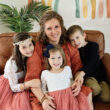I’m a cradle Catholic, and so is my husband. While our faith journeys looked different, by the time we were dating and became engaged, we were both deeply committed Catholics. Marriage prep for Catholics typically involves learning about natural family planning (NFP), that is, how fertility awareness methods (FAMs) can be used to avoid or achieve pregnancy. According to the moral law of the Catholic Church, artificial contraception (like the pill or IUD) is not permitted. However, avoiding pregnancy using NFP (which works with our knowledge of the body’s cycles) is permitted in serious circumstances, which couples are called to prayerfully discern for themselves.
So, during our engagement, we didn’t need any convincing to learn NFP. We were on board with the wisdom of what the Church taught, and with learning the ideas behind the Theology of the Body and Love and Responsibility, as described by Pope St. John Paul II (and as further elaborated on in talks by Janet Smith or Christopher West). In other words, we were ready for this!
At first, we took away the lesson that fertility was something we should control
We learned the Symptothermal Method (STM) from two long-married couples in our diocese.
One of those couples presented it as a highly regulated form of family planning through which one chooses the right time to have a child. I didn’t realize at the time the influence this lesson (and the lessons at large from my secular family) had on me in developing the idea that fertility was something we should control. Now, looking back, I realized that I took away the lesson that if fertility is something we should control, and we seek to avoid pregnancy, then it would be shameful if I got pregnant, because it would mean we “failed” to control our fertility enough (more on this later!).
But we were newlyweds and in love and, from time to time, we didn’t exactly follow “the rules” of our NFP method. We took our chances with days when there was still some chance of conceiving. The journey looked different for each child. It began with the joy of that first positive pregnancy test, followed by the crushing pain of our first miscarriage, and using NFP to avoid pregnancy until three months had passed afterwards.
Then we conceived again.
Conventional wisdom would say we shouldn’t have had any more children after our first
After the birth of our first daughter, there has never been a time in our marriage when societal or cultural wisdom would say we should have another child.The years saw us pregnant and fresh out of graduate school, at one time technically homeless, jobless, moving across the country, well below the poverty level, and without a vehicle that could fit all our children. Through each different stage of our marriage, to the outsider, we probably seemed to be a mess, still getting pregnant, still not having it together. Again, conventional wisdom would say it’s all about control, and that we lacked self-control (anytime we conceived because we didn’t follow all the rules) and should therefore be dismayed.
But internally, within the intimacy of our marriage, it didn’t feel that way at all. We were happy. Life was a grand and stressful adventure, but we were on it together. We had family support, social support, and always enough money to pay the bills. Each time we conceived, there was always an open door, a moment before the positive pregnancy test of thinking, “If I got pregnant, I’d be happy.” Or, “I am feeling ready for another one.”
But we never felt the freedom to live our married life without using NFP to avoid pregnancy, because the circumstances of our life never met the criteria of what we thought responsible parenthood looked like. So we continued to use NFP to space our pregnancies, with each of our children spaced roughly two years apart.
We received surprising news at our fourth child’s 20-week scan, but that wasn’t all
In 2015, there was another positive pregnancy test. By this time, I had experienced two miscarriages, three live births, and a lot of anxiety over the wellbeing of my unborn children.
During my son’s 20-week anatomy scan, he was diagnosed with a cleft lip and palate. After his birth, when he failed to thrive, he was hospitalized at two months old. By the time I was pregnant again in 2016, we learned our son had a life-threatening autosomal recessive genetic mutation called SPINT2. In fact, as we then discovered, all of our children had had a one-in-four chance of inheriting this life-threatening condition.
Our next child’s 20-week scan was far more devastating
The child I was carrying had that same chance. We might have to do this all over again. Anxiously, we waited for the 20-week anatomy scan. And what we learned was so much worse. Instead of a condition that could be managed with care and great doctors, our daughter would die during birth or soon after. She was diagnosed with anencephaly. She was growing without a brain.
Celeste was born on March 2, 2017, and died during birth.
After we lost our daughter, we used NFP very strictly to avoid pregnancy—but we “failed” again
After that, we became very serious about regulating our pregnancies through natural family planning. Those implicit lessons about needing to “control” ourselves and thereby our fertility, and the implication of a “failure” on our part if we got pregnant when someone else would say we shouldn’t, came back to me. If we just followed the NFP rules “better,” we could control my fertility and avoid another pregnancy. So we made greater sacrifices and abstained for longer periods. But two years later, I was pregnant again. We failed again.
Little did we know that this was the moment when the lessons we were meant to learn as an engaged couple—that NFP is supposed to work within the framework of God’s plans for us—came to the forefront. In other words, we learned the important truth that NFP leaves space where God is invited to act.
Our daughter Stella brought unimaginable healing
I could not have imagined the healing that the birth of our daughter Stella would bring me. I could not have imagined the heart-throbbing goodness of seeing that little girl run when I would never see her sister before her run, who I would never see laugh, who I could never see baptized. Stella healed my heart by her very existence. Conventional wisdom—and control—be damned!
The experience with Stella also helped my husband grow to really integrate the understanding of the weight of each sexual act between us, and to deepen his respect for me profoundly. And we began to truly understand what the Catechism of the Catholic Church means when it states that “The sacred scripture and the Church’s traditional practice see large families as a sign of God’s blessing and the parents’ generosity” (2373).
We began to question our beliefs about needing to avoid another pregnancy
Our son is now a thriving, 8-year-old boy whose life depends on medical technology and advancements. And we felt lucky with Stella, a perfectly healthy, robust little one. Surely, one might think, we shouldn’t push our chances (of having another baby with SPINT2) now! But though we used NFP for a while after Stella to avoid a pregnancy, we had learned a greater lesson, and the questions began to grow:
Would we want more children? Were we wrong in our discernment to avoid pregnancy? Would it be reckless to throw NFP out the window and just enjoy the marital embrace without guidelines or rules?
Another “failure?”
Last fall, I conceived again. We followed all the signs. Was it NFP that failed us this time? Over Thanksgiving, during my first trimester, I read the words of philosopher Dietrich von Hildebrand in a little book called Gratitude. In it, von Hildebrand writes that the vocation to suffering is a special vocation one is called to. It can be accepted with resignation, but we ought not to ask for suffering. It wasn’t for us to go recklessly after another pregnancy (and potential SPINT2 diagnosis) by “throwing all caution to the wind.”
I began to see that our discernment was what God asked of us. And while I ovulated strangely early during the cycle in which we conceived this little one, my signs were crystal clear. We weren’t being irresponsible. According to our chart, we were not in our fertile window.
Yet, we were still being open to life. We discerned a call to abstain during the time of the month we believed we were fertile, but not to avoid the chance of pregnancy altogether through sterilization or other contraceptive means. Our use of NFP left space for the Lord to work and give us the child that He planned for us. As a result, at 38 years old, I am not too many days away from meeting this new little one currently rolling around my uterus.
Another pregnancy, and another beautiful lesson
So these are the lessons that my absolutely messy, probably not magazine-worthy experience of NFP has brought to my life.
Just like sexual intimacy between a husband and a wife, NFP isn’t meant to be a one-and-done discernment, but rather a process of coming together. Together, we learn and ultimately grow to appreciate life as it is fully, and as it could be, rather than as we think it should be, if only we had our way. And as I look around me at friends who have not been able to have children, who have suffered extreme loss, or who have had some children but not as many as they wanted, I’m learning to see in a clear-eyed way the blessings God has given us in the surprising fruitfulness of my fertility.
Additional Reading:
NFP helped us avoid pregnancy to care for our daughter’s medical needs







